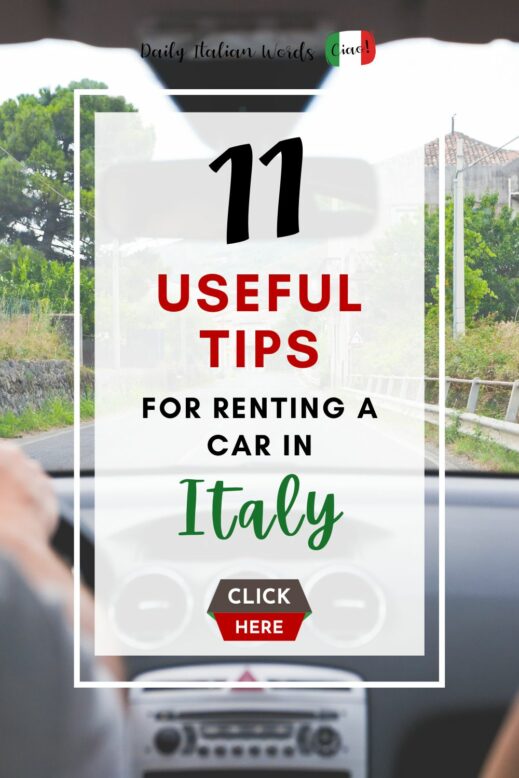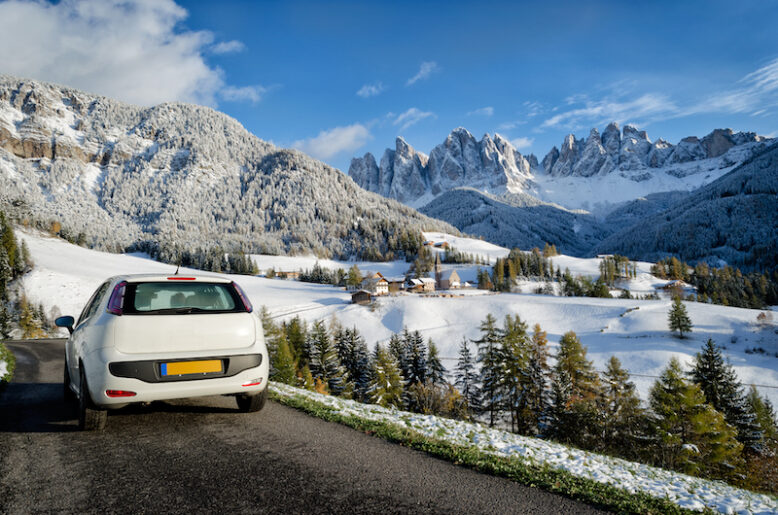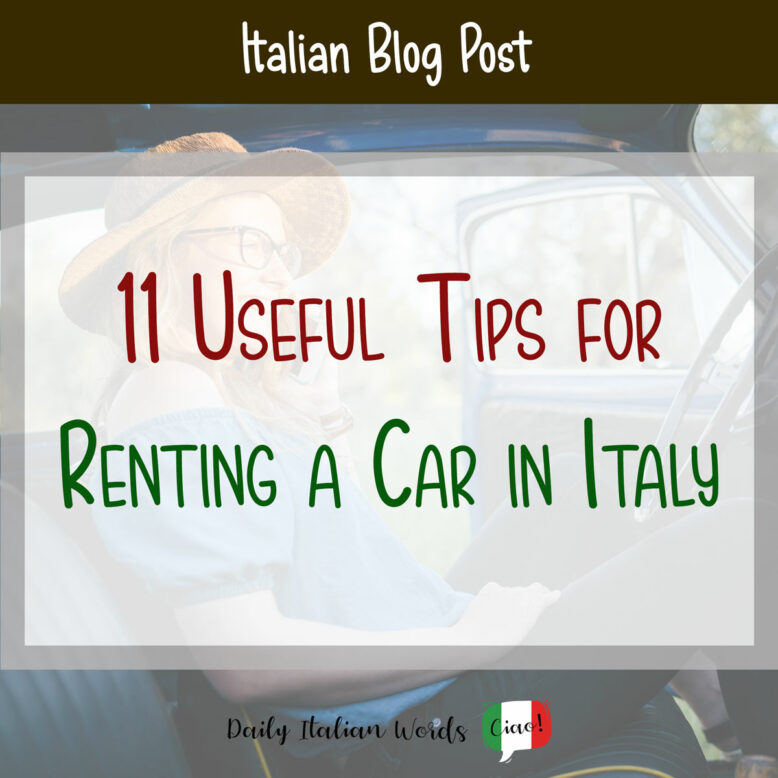11 consigli utili per noleggiare una macchina in Italia
The burning question that many confront while planning their trip to Italy is whether they should rent a car or not. And this contemplation is well-founded, considering Italy’s incredibly diverse landscape that offers an ideal setting for thrilling road trip adventures.
Quando si pianifica un viaggio in Italia, spesso ci si chiede se sia utile noleggiare una macchina. Questa è una domanda del tutto legittima, considerando la straordinaria varietà di paesaggi italiani che offrono l’ambiente ideale per emozionanti avventure su strada.
While Italy boasts a reliable public transportation network that crisscrosses the nation (with some exceptions, naturally), opting to rent a car opens the doors to an unparalleled journey through the very heart of the nation. Not to mention, there are areas where four wheels are not just recommended, but practically mandatory!
Nonostante l’Italia disponga di una buona rete di trasporti pubblici (con alcune eccezioni, ovviamente), noleggiare una macchina consente di intraprendere un viaggio senza eguali attraverso il cuore stesso del paese. Senza contare che ci sono zone in cui avere un’auto non è solo consigliato, ma praticamente obbligatorio!
With this in mind, here are 11 tips covering the key aspects you need to be aware of when it comes to renting a car in Italy.
Ecco dunque 11 consigli su aspetti chiave che è utile conoscere quando si pensa di noleggiare una macchina in Italia.

1. To rent or not to rent?
Noleggiare o non noleggiare?
Start by considering your travel plans and the places you intend to visit. If your adventure mainly revolves around big cities like Rome, Florence, or Venice, it’s best to skip the idea of renting a car. In such urban areas, a car could actually feel more like a burden than a blessing, plus public transportation networks are well-developed and can efficiently get you around.
Prima di tutto, pensa ai posti che hai in mente di visitare. Se il tuo itinerario verte principalmente su grandi città come Roma, Firenze o Venezia, è meglio scartare l’idea dell’auto a noleggio. In queste aree urbane, infatti, avere un’auto potrebbe diventare più un peso che un vantaggio, specialmente considerando che i trasporti pubblici sono ben organizzati e ti permettono di muoverti con facilità.
On the other hand, if your itinerary involves venturing into quaint towns or picturesque countryside regions such as Umbria, Apulia, or Sicily, renting a car becomes a necessity. Public transportation options in these areas might be pretty scarce and having a car allows you to access all the beautiful places that might otherwise be impossible to reach by alternate means.
D’altro canto, se il tuo programma prevede di esplorare pittoreschi paesini o regioni suggestive come l’Umbria, la Puglia o la Sicilia, allora noleggiare una macchina diventa praticamente essenziale. I mezzi pubblici in queste aree scarseggiano e avere a disposizione un’auto ti consente di visitare tutti quei luoghi incantevoli che altrimenti sarebbero difficili da raggiungere in altro modo.
A special note regarding the Amalfi Coast – unless you’re an absolute zen master on narrow, twisting roads right above the sea, forget the idea of renting a car there. Seriously, the roads along the Amalfi Coast require a lot of caution, especially when encountering larger vehicles like buses or campers on those challenging hairpin turns. And as for parking, it’s a rarity that could sneakily eat up your holiday budget!
Un consiglio importante riguardo alla Costiera Amalfitana: a meno che siate veri esperti nella guida su strade strette e tortuose a picco sul mare, è meglio lasciar perdere l’idea di noleggiare una macchina in questa zona. Le strade lungo la Costiera Amalfitana richiedono molta attenzione, soprattutto quando ci si trova di fronte a un autobus o un camper in una di quelle terribili curve a gomito. I parcheggi, poi, sono merce rara e potrebbero pesare non poco sul budget delle vacanze.
2. Opt for a smaller car… but with exceptions
Scegli una macchina piccola… con qualche eccezione
Unless you’re hauling around half your life’s belongings, going compact is your golden ticket. Italy’s charming cities and towns are often characterized by narrow streets and limited parking areas. Driving through such settings becomes much more manageable with a small car, allowing you to navigate tight spaces with ease and making your driving experience more enjoyable.
A meno che non si abbia intenzione di portare con sé mezza casa, noleggiare una macchina piccola è la scelta più sensata. Le incantevoli città e i pittoreschi paesini italiani spesso hanno strade strette e parcheggi limitati. Guidare in queste situazioni diventa molto più agevole con un veicolo di piccole dimensioni, che permette di fare manovre tra spazi ristretti con facilità e rende l’esperienza di guida ancora più piacevole.
Of course, there are exceptions. Take Tuscany, for example. Here, the idyllic rustic roads of the countryside, often unpaved and bumpy, call for a vehicle with higher ground clearance. This precaution is crucial to avoid potential scrapes and undercarriage damage, ensuring a smooth journey.
Naturalmente, ci sono delle eccezioni da tenere a mente. Pensiamo alla Toscana, ad esempio. Qui, le incantevoli strade di campagna, spesso non asfaltate e irregolari, richiedono un veicolo con una maggiore altezza da terra. Questa precauzione è fondamentale per evitare graffi e danni al telaio, garantendo un viaggio senza intoppi.
Speaking of car types, remember that manual transmission is the norm in Italy. If you prefer an automatic car, it’s best to book it well in advance, especially in high season.
A proposito di tipologia di auto, è importante sapere che in Italia la norma è rappresentata dal cambio manuale. Se preferisci un’auto con cambio automatico, è consigliabile prenotarla con largo anticipo, soprattutto durante la stagione turistica.
3. Remember the car seat
Ricorda il seggiolino
If you’re traveling to Italy with kids, don’t forget to make the necessary arrangements to ensure proper car seats or safety devices in accordance with the country’s regulations. According to Italian law, children must use a car seat until they turn 12 years old, reach a height of 150 cm, or weigh at least 36 kg. Moreover, there’s a recent update mandating the use of anti-abandonment devices for children under 4 years old.
Se hai in programma un viaggio in Italia con bambini al seguito, è fondamentale prepararsi adeguatamente per garantire la loro sicurezza in auto, rispettando le regole locali. Secondo la legge italiana, i bambini devono essere sistemati su seggiolini appropriati fino a quando raggiungono i 12 anni di età, un’altezza di 150 cm o un peso di almeno 36 kg. Inoltre, una recente normativa richiede l’uso di dispositivi anti-abbandono per i bambini sotto i 4 anni.
Most car rental companies offer a variety of car seat options tailored to different ages and weight categories. However, make sure to book yours well in advance, simultaneously with your car rental reservation, to ensure availability. Another option is to consider renting car seats from specialized websites that focus on child-related products, such as Babonbo or Mammamamma.
La maggior parte delle compagnie di noleggio offre diverse opzioni di seggiolini per diverse fasce d’età e peso. È meglio richiedere il seggiolino già durante la prenotazione dell’auto per essere certi che sia disponibile. Un’alternativa da considerare è il noleggio del seggiolino da siti web specializzati nell’ambito dei prodotti per l’infanzia, come ad esempio Babonbo or Mammamamma.
4. Gather all the necessary documents
Prepara tutti i documenti necessari
When renting a car in Italy, there are a few important things to keep in mind beyond just your regular driving license from your home country. An absolute must is having a credit card on hand (in the name of the primary driver), as cash payments and deposits won’t be accepted.
Quando decidi di noleggiare una macchina in Italia, ci sono alcune cose da tenere presenti, al di là della patente di guida del tuo paese di origine. Uno dei requisiti fondamentali è avere una carta di credito a nome del conducente principale, poiché le compagnie di noleggio non accettano né pagamenti né depositi in contanti.
Equally essential is your passport – while this might seem obvious, it’s always good to reiterate. Speaking of personal details, remember that the legal driving age in Italy is 18 years old. However, if you’re under 25 years of age, certain car rental agencies might apply an extra fee.
Inoltre, non dimenticare di portare con te il passaporto – anche se sembra ovvio, è sempre utile ricordarlo. A proposito di dati personali, è importante sapere che l’età minima legale per guidare in Italia è di 18 anni. Tieni presente che se hai meno di 25 anni, alcune agenzie di noleggio potrebbero applicare costi aggiuntivi.
Additionally, if you are not a resident of the European Union, remember that the Italian law requires an international driver’s permit. You can get one from your local automobile association (more info here). And don’t worry, there are no exams involved! While the car rental company might not always ask for it, having the permit on hand is essential during police stops or in case of accidents. Not having one could lead to a significant fine.
Se non sei un residente dell’Unione Europea, ricorda che la legge italiana richiede un permesso di guida internazionale. Lo puoi richiedere presso l’associazione automobilistica locale (trovi ulteriori informazioni qui). Non preoccuparti, non ci sono esami da sostenere! Anche se potrebbe non essere sempre richiesto dalla compagnia di noleggio, è fondamentale avere il permesso con sé durante i controlli della polizia o in caso di incidenti. Non averlo potrebbe comportare il pagamento di una multa piuttosto salata.
5. Make sure the car is in good shape
Assicurati che l’auto sia in buone condizioni
Before you hit the road in your snazzy rental car, take a moment to walk around and carefully record its condition. If you happen to return the car with damages that weren’t on the pickup documentation, your wallet might take a serious hit because as you might find yourself held financially accountable for the repairs. Oh, and if you are renting the car in winter, make sure you’re all set with snow tires or snow chains, as they are mandatory between November and April.
Prima di metterti per strada con la tua auto a noleggio, prenditi un momento per dare un’occhiata e annotare con attenzione il suo stato. Se dovessi restituire l’auto con danni non segnalati nella documentazione del ritiro, il tuo portafoglio potrebbe risentirne, poiché potresti essere ritenuto responsabile dei costi delle riparazioni. Inoltre, se noleggi l’auto in inverno, assicurati che l’auto sia provvista di pneumatici da neve o di catene, indispensabili da novembre ad aprile.
In any case, if you spot any issues with the car during the pickup inspection, don’t hesitate to raise the flag. You can request an alternative vehicle or have the rental company address the issues before you start your journey. Taking these steps could potentially save you both time and inconvenience during your trip.
In ogni caso, se noti eventuali problemi al momento del ritiro, non esitare a farli presente. Puoi richiedere un veicolo alternativo o chiedere alla compagnia di noleggio di risolvere i problemi prima di metterti in viaggio. Questi passaggi sono fondamentali per evitare inutili disagi e perdite di tempo lungo la strada.

6. Know you car rental insurance options
Esplora le opzioni di assicurazione per il noleggio auto
All car rental rates in Italy typically include the basic Collision Damage Waiver, Theft Protection, and third-party liability car insurance, all of which are mandatory. Additionally, car rental companies provide optional add-ons for increased protection, such as coverage for mechanical or glass damage. These add-ons can be conveniently purchased either online at the time of booking or directly at the counter when picking up the car.
In Italia, le tariffe di noleggio auto in genere includono di default l’assicurazione base per i danni da collisione, la protezione dal furto e la responsabilità civile verso terzi, obbligatorie per legge. Tuttavia, le compagnie di noleggio offrono anche ulteriori servizi opzionali per una protezione extra. Questi servizi possono comprendere la copertura per danni meccanici o al vetro, e altro ancora. È possibile aggiungere questi servizi sia online al momento della prenotazione che direttamente al banco al momento del ritiro dell’auto.
While slightly more expensive, opting for an all-inclusive car rental insurance is the wisest choice for complete peace of mind during your trip. It is quite easy to unintentionally damage the rental car and the last thing you want is the stress of scrutinizing every minor issue while driving. Also, it’s a good idea to verify whether your credit cards provide car rental coverage that’s valid in Italy.
Sebbene questa opzione possa risultare leggermente più costosa, scegliere un’assicurazione con copertura completa rappresenta la scelta più oculata per goderti il viaggio in tutta tranquillità. Piccoli graffi o segni possono accadere con molta facilità, e l’ultima cosa che vuoi è doverti preoccupare di questo mentre sei al volante. Inoltre, potrebbe essere utile verificare se le tue carte di credito offrono una copertura assicurativa per il noleggio auto valida in Italia.
Lastly, remember that you need to have proof of insurance in the car whenever you’re driving, along with the car’s documentation. In the event of a police stop, they will ask to see these documents.
Infine, ricorda di avere sempre con te la copia dell’assicurazione, insieme alla documentazione relativa all’auto. Nel caso in cui dovessi essere fermato dalle autorità, ti verrà sicuramente richiesto.
7. Familiarize yourself with the rules
Familiarizza con le regole
Driving in a foreign country can be challenging due to differences in driving rules, road signage and etiquette. Knowing both the official and unofficial rules, reduces the risk of accidents and fines arising from misunderstandings or misinterpretations.
Guidare in un paese straniero può essere una sfida a causa delle differenze nelle regole di guida, nella segnaletica stradale e nel comportamento degli automobilisti. Conoscere sia le regole ufficiali che quelle non scritte può aiutarti a ridurre il rischio di multe e incidenti dovuti a malintesi o interpretazioni errate.
First of all, keep in mind that when driving in Italy, you must stick to the right side of the road and utilize the left lane for passing. At roundabouts (you’ll find many), priority must be given to cars coming from your left.
Innanzitutto, tieni presente che quando guidi in Italia, devi tenere la destra e utilizzare la corsia sinistra solo per sorpassare altri veicoli. Nelle rotonde, che sono piuttosto comuni, è necessario dare la precedenza alle auto che arrivano dalla tua sinistra.
Don’t even think of speaking on your cellphone while driving. Not only it’s super dangerous, but it also comes with substantial fines. Also, remember that the legal alcohol limit is pretty low in Italy, so if you’re planning to take your rental car to dinner, you might want to slow down with those homemade amari.
Scordati di usare il cellulare mentre sei al volante. Questo comportamento non solo è estremamente pericoloso, ma può comportare anche sanzioni considerevoli. Ricorda inoltre che il limite consentito di concentrazione di alcol nel sangue in Italia è piuttosto basso. Quindi, se hai in programma di usare l’auto a noleggio per andare a cena, meglio andarci piano con gli amari della casa.
Lastly, stay attentive to changes in speed limits indicated by signs along the road, and watch out for those “speed camera” signs as well or else you might get hefty fines. Oh, and an oncoming vehicle flashes its headlights, it is a courteous signal indicating a police checkpoint ahead. Although this practice is against official rules, it is quite common.
Infine, tieni d’occhio i cambiamenti nei limiti di velocità indicati lungo la strada e fai attenzione anche ai segnali che indicano la presenza di telecamere di controllo della velocità. In caso contrario, potresti trovarti a dover pagare multe piuttosto salate. Inoltre, se una macchina proveniente dalla direzione opposta lampeggia i fari, consideralo un gesto cortese per avvertirti che troverai un posto di blocco. Nonostante questa pratica sia contraria alle regole ufficiali, è piuttosto comune.
8. Steer clear of gas stations on the highways
Evita i distributori di benzina lungo le autostrade
Make sure to plan your fuel stops strategically by choosing off-highway gas stations. While highway service areas might offer convenience, their fuel prices tend to be higher, often accompanied by surcharges in the range of 15-20%. This rule is particularly crucial given the current high gas prices in Italy.
Pianifica con cura le soste per il rifornimento di benzina, optando per distributori fuori dall’autostrada. Certo, le aree di servizio lungo l’autostrada sono piuttosto comode, ma va considerato che i prezzi del carburante tendono ad essere più alti, con sovrapprezzi nell’ordine del 15-20%. Questo consiglio è particolarmente prezioso dato l’attuale aumento dei costi del carburante in Italia.
So, when you find yourself driving on the highway and in need of a refueling, it’s worth considering taking an exit for a quick break and refuel – though this isn’t always the most practical choice. More in general, it’s better to start the journey with a full tank before entering the highway.
Quando ti trovi in autostrada e hai necessità di fare benzina, valuta la possibilità di prendere la prima uscita per una breve pausa e per fare rifornimento – anche se questa opzione potrebbe non essere sempre la più pratica. In generale, conviene sempre partire con il serbatoio pieno prima di immettersi in autostrada.
9. Use Google Maps with moderation
Usa Google Maps con moderazione
Google Maps, our trusty navigation companion, proves to be an incredibly valuable tool when renting a car in Italy, ensuring that you arrive at your intended destinations efficiently – well, at least most of the time.
Google Maps è il nostro fidato compagno di viaggio, particolarmente prezioso quando ci troviamo alla guida di un’auto a noleggio. Questo strumento, infatti, ci aiuta a pianificare in modo efficiente il percorso verso le nostre destinazioni – almeno nella maggior parte delle situazioni.
This digital navigator typically indicates the quickest routes to guide you to your desired spots, but sometimes it gets a bit too cozy with the shortest paths, leading you onto some seriously tricky roads. Not exactly the thrill you signed up for, right? So, when you’re driving through rustic landscapes like the picturesque region of Molise or the hills of Oltrepò Pavese, it’s wiser to trust those good old traditional road signs.
Questo navigatore digitale di solito suggerisce i tragitti più rapidi per raggiungere i luoghi desiderati, ma a volte può rivelarsi eccessivamente audace, indirizzandoci verso strade piuttosto complesse, rovinando il viaggio. Ecco perché, quando ci troviamo a viaggiare attraverso paesaggi rurali come ad esempio la splendida regione del Molise o le colline dell’Oltrepò Pavese, è più saggio affidarsi ai buoni e vecchi segnali stradali tradizionali.
10. Watch out for the dreaded ZTL
Fai attenzione alle temibili ZTL
In Italy, the ZTLs (Zone a Traffico Limitato) are limited traffic zones within cities or towns where access by vehicles is restricted or limited, usually to reduce air pollution and to protect historical and cultural heritage. They can be either permanent or temporary and where these restrictions are in place, only authorized vehicles are allowed to circulate in these areas.
In Italia, le ZTL (Zone a Traffico Limitato) sono aree all’interno delle città o dei paesi in cui la circolazione dei veicoli è limitata o addirittura vietata. Queste restrizioni sono spesso mirate a ridurre l’inquinamento dell’aria e a preservare il patrimonio storico e culturale. Le ZTL possono essere permanenti o temporanee e, nelle zone interessate, solamente i veicoli autorizzati hanno il permesso di accedere.
ZTLs are typically monitored by surveillance cameras and marked by specific signs but it’s easy to miss them. So, keep your eyes wide open when driving in town centers because unauthorized entry into these zones can lead to big fines.
Le ZTL vengono monitorate da telecamere e segnalate da appositi cartelli, ma spesso sfuggono all’attenzione. Quindi, quando ci si trova a guidare all’interno dei centri urbani, è importante guardarsi bene intorno: entrare in queste zone senza autorizzazione, infatti, può comportare sanzioni piuttosto cospicue.
11. Have a parking strategy
Pianificazione, la chiave per parcheggiare
The quest for the perfect parking spot can feel like an epic adventure in itself when driving in Italy, yet it’s an integral part of the experience. When it comes to on-street parking, your guiding stars are the colorful lines: white means free parking (though a parking disk is sometimes required), yellow is typically reserved for residents and disabled people, while blue indicates paid parking. Keep coins at hand for parking meters and take a picture of your license plate, as you’ll often need to insert it to obtain a parking ticket.
Trovare parcheggio può diventare un’avventura epica, ma è parte integrante dell’esperienza di guida in Italia. Quando si tratta di parcheggiare sulla strada, le linee colorate sono le tue guide: le linee bianche indicano parcheggio gratuito (anche se talvolta è richiesto l’uso del disco orario); il giallo è generalmente riservato ai residenti e ai disabili; il blu segnala parcheggio a pagamento. Assicurati di avere monete a portata di mano per i parcometri e scatta una foto alla tua targa, poiché spesso dovrai inserirla per ottenere il biglietto di parcheggio.
Especially in popular city centers, parking garages are a safe harbor. But if you want to avoid the often steep rates, plan to arrive early in the morning to increase your chances of securing a parking spot before the crowds arrive. Alternatively, consider parking on the outskirts and either walking or using public transportation to reach the city center.
Specialmente nei centri più famosi, i parcheggi coperti rappresentano un rifugio sicuro. Tuttavia, se desideri evitare le tariffe spesso elevate, programma di arrivare presto al mattino per aumentare la probabilità di trovare un comodo parcheggio prima che arrivi la folla. In alternativa, considera la possibilità di parcheggiare fuori dal centro città e poi spostarti a piedi o utilizzare i mezzi pubblici.
One last word of caution: while it’s generally wise to embrace local customs, this principle doesn’t extend to parking. Italians are renowned for their mastery of the double parking technique, but don’t emulate this practice, as it could result in fines or agitate the local residents.
Un ultimo consiglio: sebbene sia sempre saggio adattarsi alle usanze locali, questo principio non vale per il parcheggio. Gli italiani sono noti per la loro abilità nell’arte del parcheggio in doppia fila, ma evita di imitarli poiché potresti incorrere in multe o infastidire non poco i residenti.


Valentina Nicastro is a travel writer in love with her home country, Italy. Having travelled widely around the globe, she realised there was more to explore closer to home and decided to put the passport aside for a while. When she is not immersed in documenting Italy, you’ll find her donning her communication consultant hat, weaving words as a content writer and bridging linguistic divides as a translator.


